by Albert D. Kollar
Potable Water Sources
Access to drinking water from a water fountain seems to be passé today with the ubiquitous availability of plastic water bottles from vending machines. In 2018, as an effort to ‘change the culture’ in the use of plastic water bottles by museum staff and patrons, the Oakland museums, Carnegie Museum of Natural History, and Carnegie Museum of Art (respectively CMNH and CMOA), installed filling stations for reusable water bottles. These eco-friendly “fountains” are located adjacent to the Fossil Fuels Cafeteria in CMNH, and in the rest room lobby of CMOA1 (Fig. 1), and their rapid and wide acceptance invites a deeper consideration of drinking water as an amenity in a public facility.
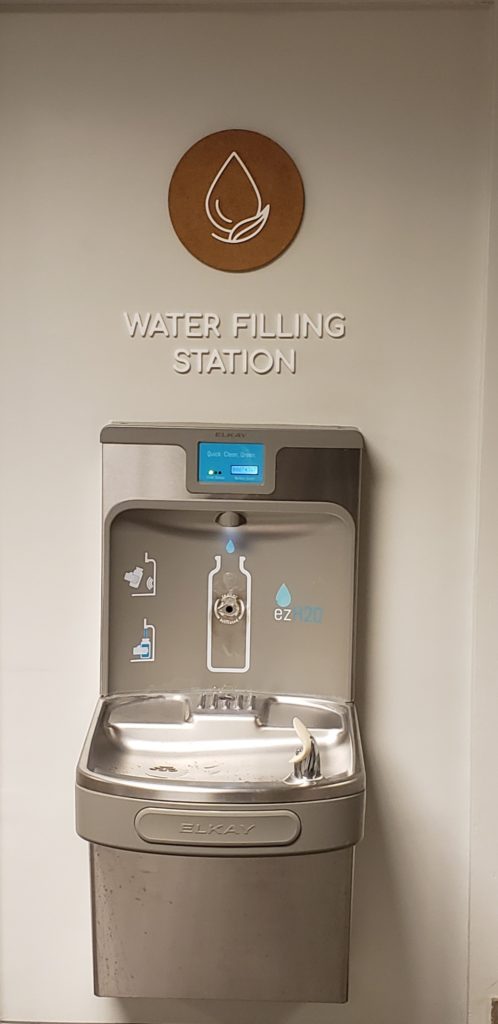
The public water supply in the massive Oakland building comes from the Pittsburgh Water and Sewer Authority’s Herron Hill Reservoir, which in turn draws its supply from the Highland Park Reservoir in the city’s East End1. The water, which is initially sourced from the Allegheny River, undergoes several treatments before it is pumped to the reservoir.
The geologic perspective on our water supply also bears mention here. The glacial melt waters of the Pleistocene Epoch filled the potable aquifers of western Pennsylvania2 (Fig. 2 red arrows). With population growth in the 20th Century, water demands for agricultural, industrial, and residential uses led to the depletion of these aquifers within the Allegheny River Basin. Today potable waters stored in reservoirs are principally drawn from the three rivers of Pittsburgh, waterways replenished to a significant degree by rain fall and snow melt.
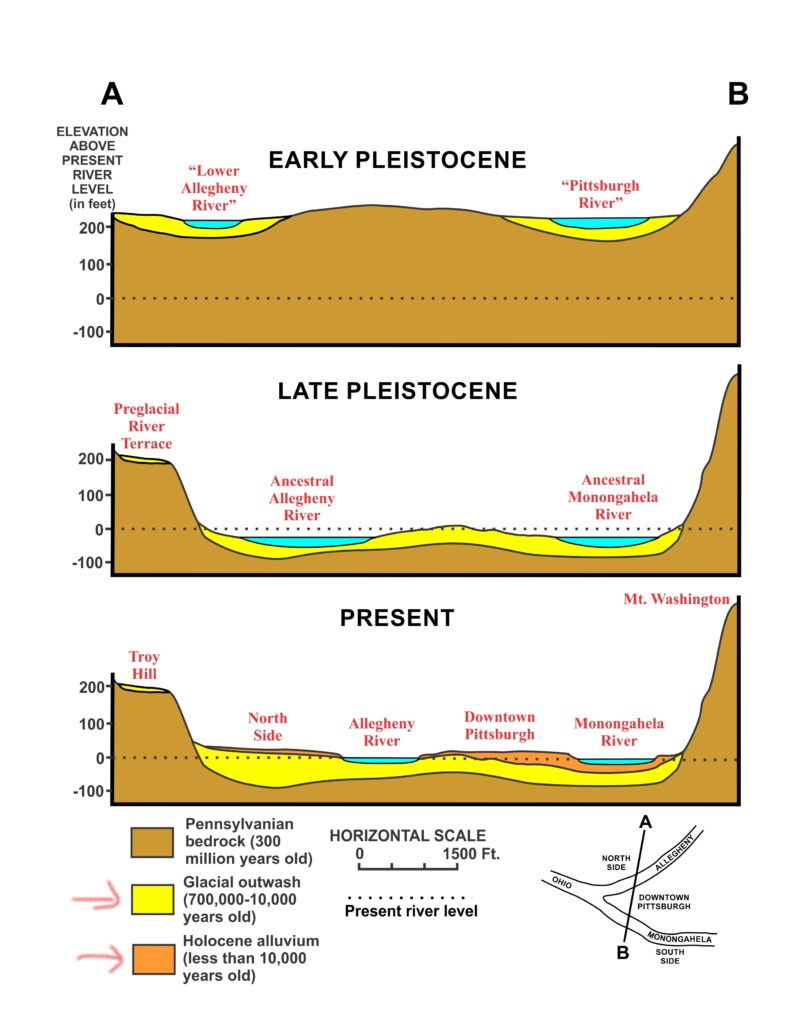
A myth in the minds of many Pittsburghers is the city’s Fourth River. According to a 2016 publication by John Harper2, the Fourth River does not exist as underground caves, fissures, or cavities under any of the three rivers. As shown in Fig. 2, (red arrows) glacial outwash and Holocene alluvium comprise thick deposits of sediment within the river valleys, and tiny interconnected pore spaces between sand grains and pebbles allow water from the rivers and their adjoining floodplains and riverbanks, to move slowly but freely through this sediment. At some locations this subterranean flow is accessed by artesian wells, the most prominent example being the fountain in Point State Park.
Carnegie’s Water Fountains
Presentation is important, especially for something as vital as drinking water, and within the halls and hallways of the Carnegie building complex in Oakland, carved stone is frequently part of the refreshment package. Visitors encounter three types of water fountains. In the 1907 Carnegie Institute Extension, a Beaux-Arts masterpiece designed by architects Alden and Harlow, water fountains are plumbed through either white Carrara Marble from Italy or yellow Hauteville fossil limestone of France. In the Museum of Art wing built in 1974, thirsty patrons are served by chrome water fountains (Fig. 3).
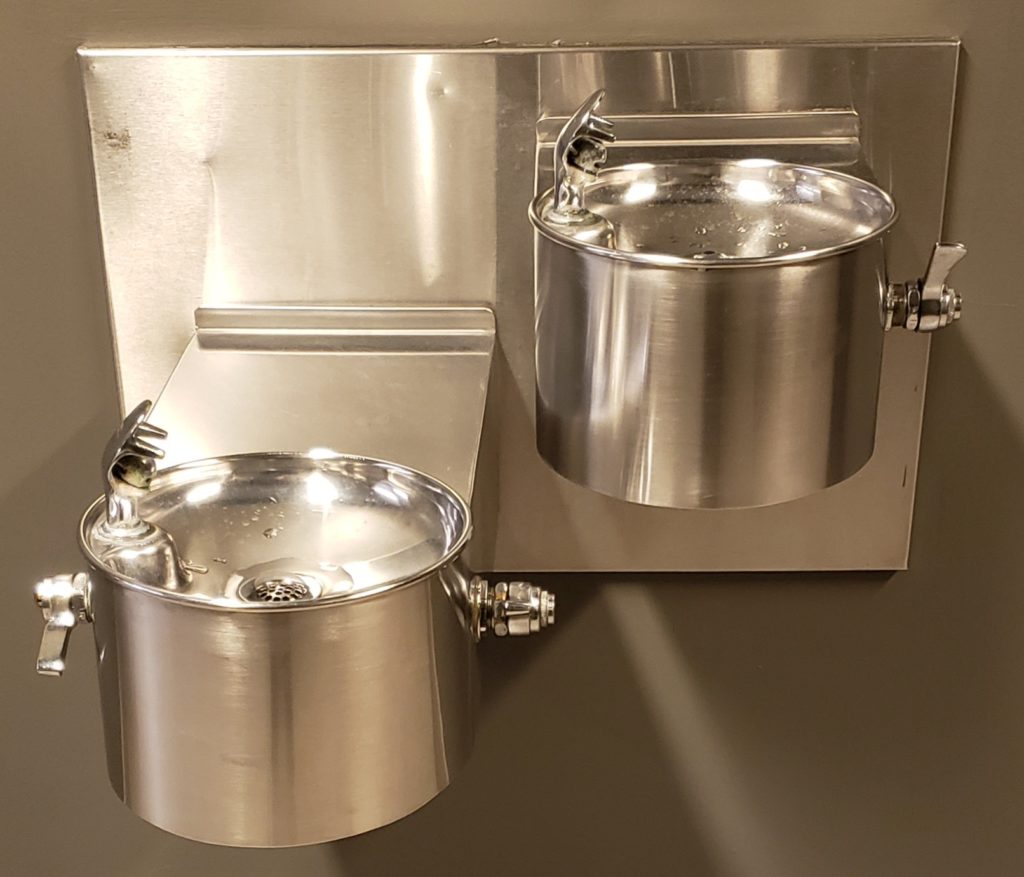
Carrara Marble was created during the Cenozoic Era when limestones formed during the Triassic or early Jurassic age limestones underwent metamorphosis.4 The locations of the eighteen Carrara Marble fountains in the 1907 building include the engine room, basement hallways, the Carnegie Library of Pittsburgh first floor lobby (Fig. 4), Carnegie Music Hall vestibule hallway, the Carnegie Lecture Hall, and exhibit halls on the second and third floors of Carnegie Museum of Natural History.3 Although the Carrara Marble fountains originally had red brass fixtures (Fig. 4), some now operate with replacement fixtures of chrome1.
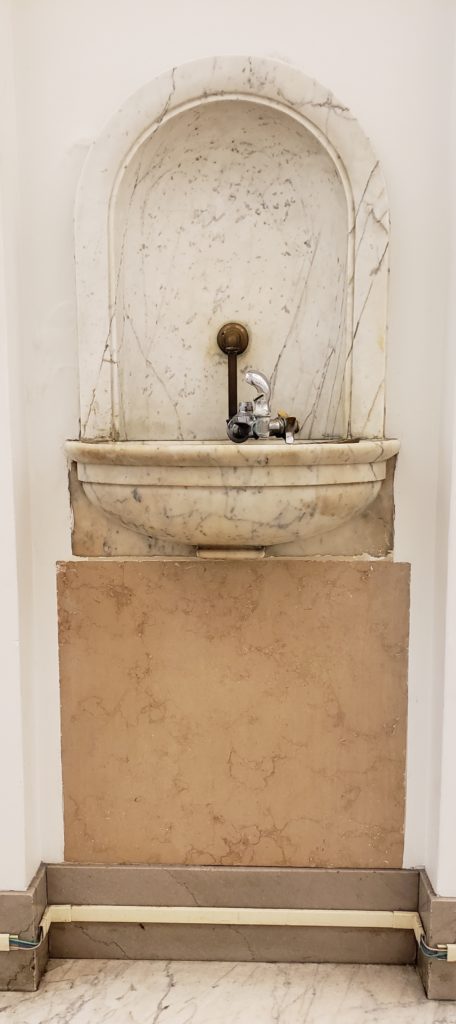
There are three Hauteville limestone fountains along the walls of the three floors in the Grand Staircase Hall. These neo-Baroque fountains feature carvings that represent a diverse group of invertebrate fossils and an allegory human face (Fig. 5). The fountains are surrounded by the Hauteville limestone wall panels with Cretaceous age snail Nerinea (Fig. 6) visible in many Hauteville floor tiles, walls, door framing, and pedestals.5 Some 350 tons of Hauteville limestone were used for the interior stone in the Grand Staircase and throughout the Carnegie Institute Extension.6 The Hauteville fountains also originally used red brass fixtures, and now function with chrome replacements.
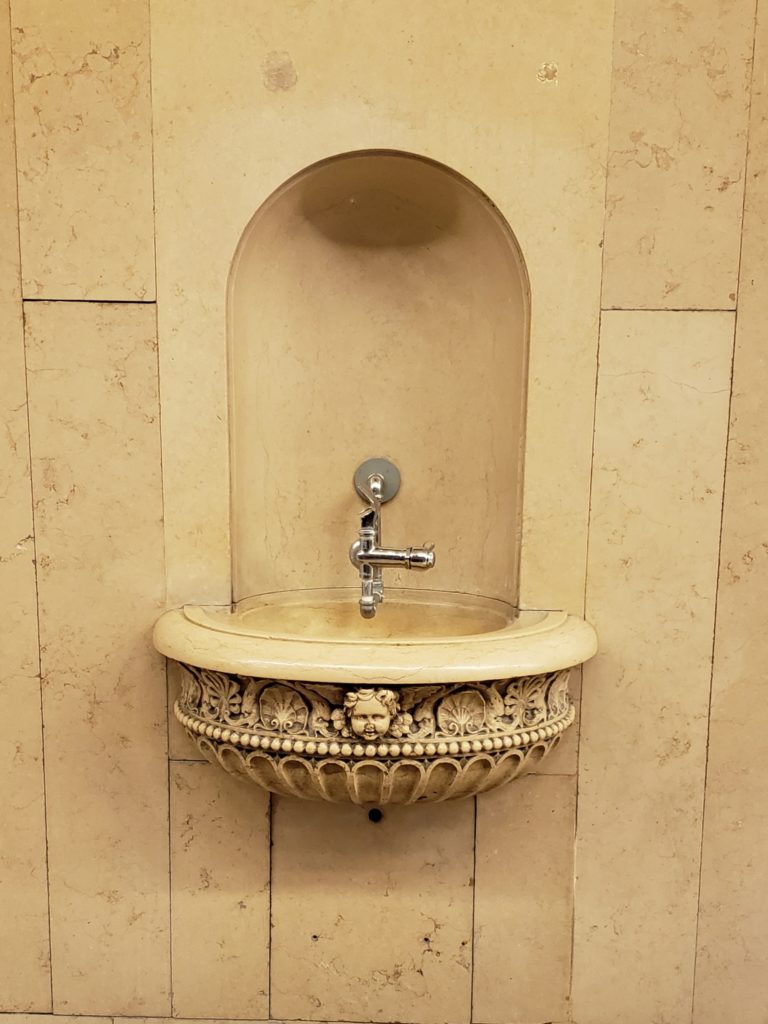
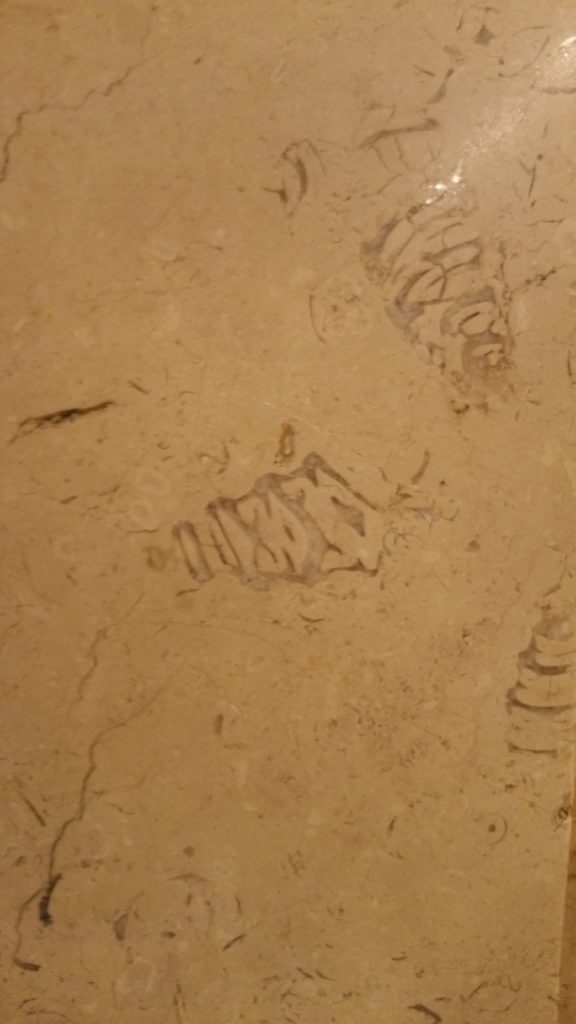
A World-Famous Fountain In Rome And More
If there’s a place in a discussion of fountains to consider the top of the scale, an Italian reference belongs here. One of the most famous water fountains in the world is the Baroque Trevi Fountain (Nicola Salvi, Giuseppe Pannini, architects) that opened in 1762 in Rome7. The fountain had its moments in classic movies such as, Federico Fellini’s La Dolce Vita (1960) with Marcello Mastroianni and Anita Ekberg in the leads8 (Fig. 7, image by Hernán Piñera).
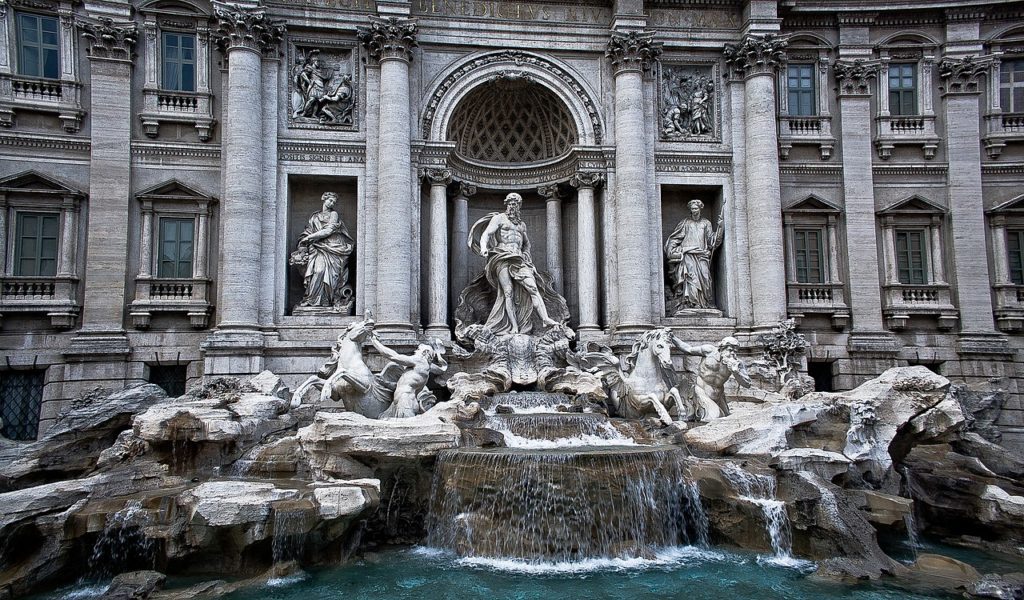
Around 19 BC, aqueducts were constructed in ancient Rome to bring pure water to the city from mountains 13 km (8.1 mi) from Rome9. Roman citizens enjoyed the function of a fountain not only as a source of clean water but as a gathering place.
The Trevi Fountain is made of travertine, a sedimentary limestone (calcium carbonate) quarried in the Italian village of Bogni di Tivoli10. The village is noted for travertine quarries that produced the exterior stone for the Roman Amphitheater opened in 80 AD11 and the building of the Getty Museum in Los Angeles, California (1997).
Travertine forms when ground water combines with carbon dioxide in the soils to form carbonic acid waters that then dissolve subsurface limestone. As these calcium carbonate-concentrated waters flow through the cracks in the bedrock they eventually precipitate a new rock called travertine.
An excellent example of travertine formation can be observed at Mammoth Hot Springs in Yellowstone National Park. High above the Hot Springs, rainwater seeps into the buried Cretaceous age limestone where it mixes with carbon dioxide gas that rises from a subterranean magma chamber dissolving the calcium carbonate that is carried along in the underground streams through fractures in the overlying strata. Once the water exits the bedrock, travertine terraces start to build as the carbon dioxide gas escapes, leaving behind the calcium carbonate mineral.
Travertine in Oakland: In an abandoned sandstone quarry behind Phipps Conservancy in Schenley Park travertine deposits is preserved on the exterior of the quarry rock12. The site is no longer open for visitors.
Albert D. Kollar is the Collection Manager for the Section of Invertebrate Paleontology. Museum employees are encouraged to blog about their unique experiences and knowledge gained from working at the museum.
References
- Young, T. Carnegie Museum of Pittsburgh Facilities.
- Harper, J. A. 2016. The Geological Evolution of Pittsburgh’s Three River. PAlS Publication 21.
- Kollar et al. 2020. Connemara Marble at the Carnegie Institute Extension. ACM, 86, 207-2
- Price, M. T. 2007. The Sourcebook of Decorative Stone: An Illustrated identification guide. 287 pp.
- Kollar, A. D. 2020. https://carnegiemnh.org/carnegie-museum-grand-staircase/
- Kollar, A. D. 2021 DE L’ÉCHAILLON À L’ANNEXE DU CARNEGIE INSTITUTE DE PITTSBURGH Saint-Quentin-sur-Isère, 18 Septembre 2021.
- Pinto, J. A. 1986. The Trevi Fountain. Yale University Press. 326 pp.
- Fellini, F. 1960. La Dolce Vita. The Criterion Collection, Paramount Home Entertainment
- Beard, M. 2015. SPOR A History of Ancient Rome. Liveright Publishing Corporation. 606 pp.
- Hirt, A. M. 2010. Imperial Mines and Quarries in the Roman World Organizational Aspects 27 BC-AD 235. Oxford Press, 551 pp.
- Acocella, A. 2013. Travertine, An Italian Stone. Journal ARCHITETTURA DI PIETRA.
- Kollar, A. D. The Geology of Oakland, in manuscript.
Related Content
Understanding Fossil Fuels through Carnegie Museum Exhibits
A Century Ago, a Donor Walked into the Museum
The Connemara Marble: A Cross-Atlantic Connection Between Ireland and Pittsburgh
Carnegie Museum of Natural History Blog Citation Information
Blog author: Kollar, Albert D.Publication date: December 14, 2021
